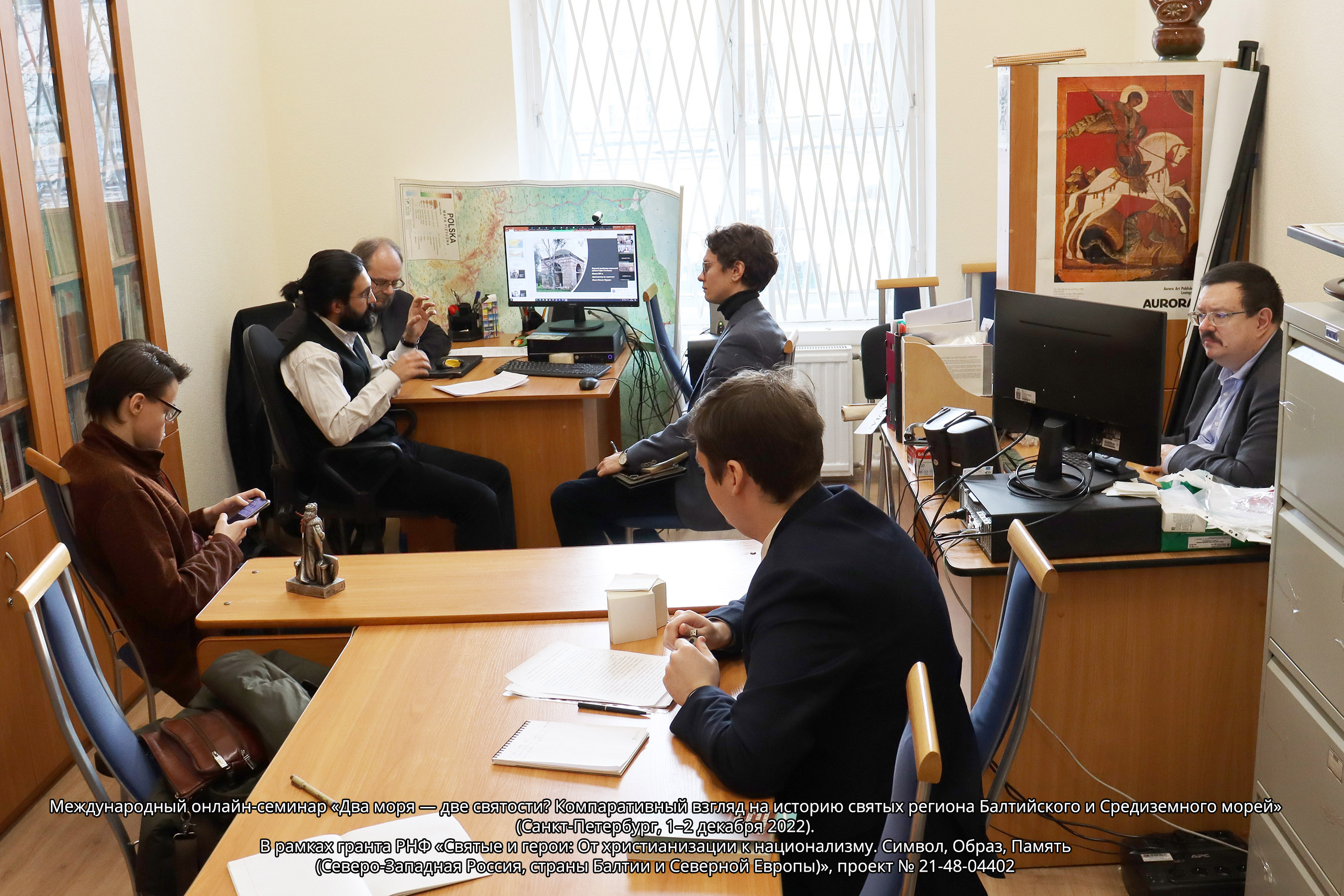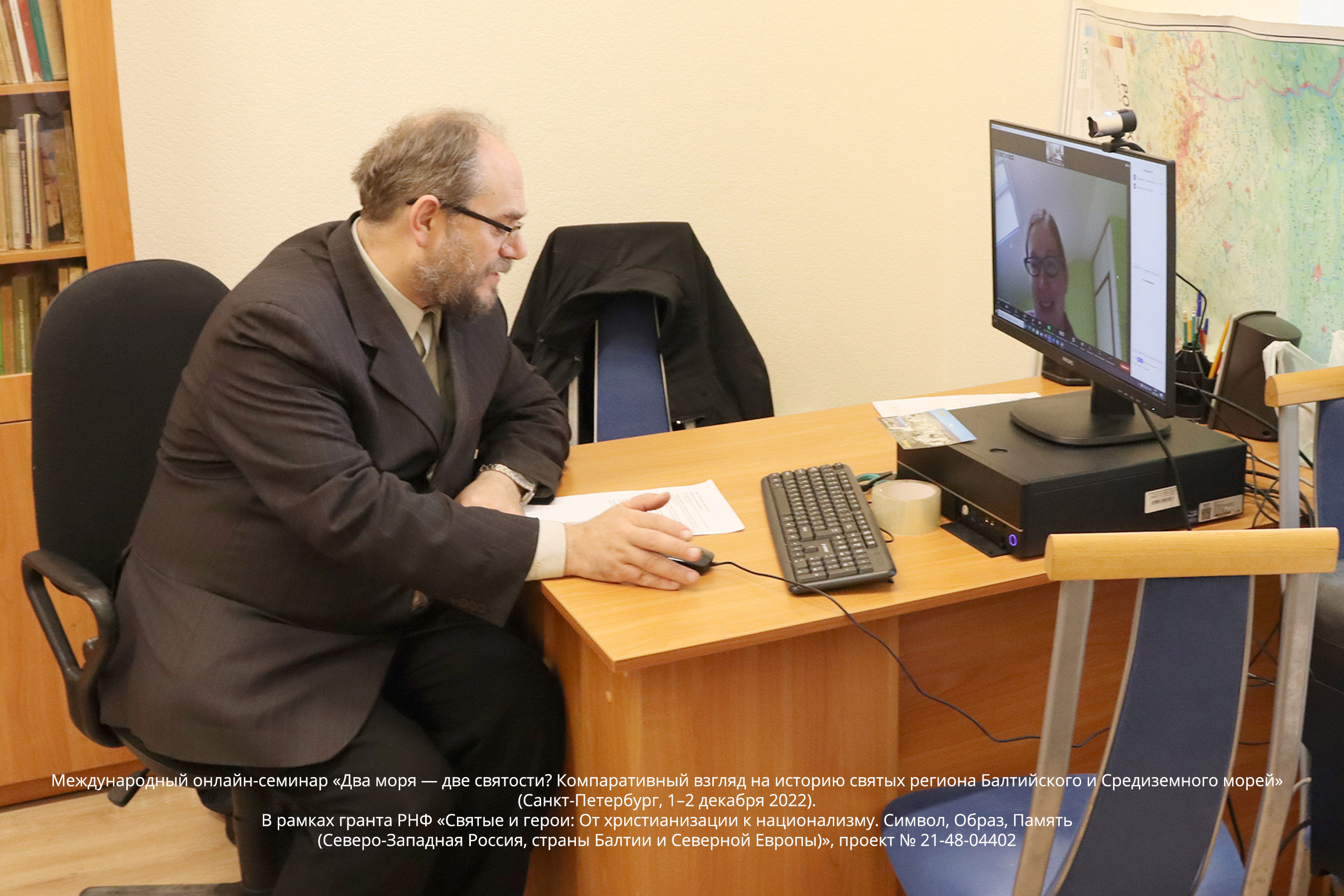«Two seas — two sanctities?» A comparative view of the history of saints in the Baltic and Mediterranean regions
On International online seminar, St Petersburg State University, 1–2 December 2022
In early December, scholars came together to discuss the shaping of sanctity ideas in the Baltic and Mediterranean regions. Historiographers believe that the ideas of sanctity and saints developed according to several models. The «aristocratic» or «royal model» of sanctity prevailed in northern Europe, in the Baltic and North Atlantic countries, where mainly kings, aristocrats and bishops were venerated as saints. The Mediterranean model was more democratic, with more holy men from lower and middle social strata: townspeople, monks, warriors. At the same time, these models did not exclude canonisation of kings in the Balkans (e. g., the hero of the Battle of Kosovo, Lazar Hrebeljanovic) and ordinary people in the Baltic (e. g., the Norwegian villager Hallvard Vebjornsson, who became the patron saint of Oslo).
The concepts of sanctity developed under the influence of the Catholic and/or Orthodox Churches, Rome and/or Byzantium. The Reformation played a huge role in Northern Europe, changing the views of and approaches to the concept of sanctity and saints, while in the south the fall of Byzantium and the Ottoman conquest redrew not only the political but also the ecclesiastical map. Orthodox Rus had a role to play in these processes, having taken the course to the emancipation from the Church of Constantinople and becoming autocephalous in 1448.
The participants discussed the following issues:
- models of sanctity in the Baltic and Mediterranean regions
- the features of the saints’ cults in the Baltic and Mediterranean regions (veneration, hagiography, relics, etc.)
- comparative analysis of the ideas of sanctity and saints in the Baltic and Mediterranean regions
- the church and saints’ cults in the Baltic and Mediterranean regions (church dedications, frescoes and iconography, canonisation, etc.)
- the role of the state and society in the formation of saints’ cults in the Baltic and Mediterranean regions
Historians from St. Petersburg, Moscow, Novgorod, Novi Sad (Serbia) and Belgorod (Serbia) discussed the shaping of sainthood ideas in the two regions, the formation of saint cults, their spread in Europe and their role in the development of new states and cultures. The seminar focused on Western and Central Europe, North-West Russia, Byzantium, and the Balkans — the countries of the Baltic Sea and the Mediterranean. Historians shared their research results and observations on the cult of saints in the colonizing activities of the German Order in the 13th — 16th centuries, the use of saints’ images in clerical services and as a tool in wars and struggle for the faith, and the role of the cult of saints in politics and culture. The lectures covered the period from the Middle Ages to the 20th century.
Seminar programme
December 1st. 10:00–13:00
Session one. Saints on the Baltic coast
Moderator: Alexander Filyushkin
Dmitriev, Mikhail Vladimirovich (Moscow State University, Higher School of Economics). The saints’ cult and religious intolerance in the colonisation experience of the Teutonic Order in the Baltic in the 13th – 15th centuries Listen to the presentation
Bessudnova, Marina Borisovna (Novgorod State University). Pious motivations for the behaviour of the brothers of the German Order at the turn of the 15th – 16th centuries in the light of the Order Rule and routine administration Listen to the presentation
Sukina, Lyudmila Borisovna (Ailamazyan Institute for Software Systems of the Russian Academy of Sciences). Saints who came from across the sea: the «German» model of holy foolishness in medieval Rus Listen to the presentation
Prokopyev, Andrey Yurievich (St Petersburg State University). At the service of the clergy and world: St Benno in Saxony’s fate Listen to the presentation
Filyushkin, Alexander Ilyich (St Petersburg State University). «Translatio Sanctitatis» as an instrument of wars for the Baltic in the Middle Ages and early modern times
Kostoromin, Konstantin Alexandrovich (St Petersburg Theological Academy). Russian saints and the struggle against Roman Catholicism in the 15th – 16th centuries: Byzantium or the Baltic? Listen to the presentation
December 1st. 14:00–18:00
Session two. Saints of the Northwest of Russia and the Grand Duchy of Lithuania
Moderator: Natalia Turygina
Romanova, Anastasia Anatolievna (Library of the Russian Academy of Sciences, St Petersburg). Saints of the Novgorod Land in the «Book called the Description of Russian Saints»
Selin, Adrian Alexandrovich (Higher School of Economics National Research University, St Petersburg). On church dedications in the 16th – 17th centuries in the Novgorod Land Listen to the presentation
Medvedev, Kirill Maksimovich (St Petersburg State University). Josaphat Kuntsevych – the patron saint of the Polish-Lithuanian Commonwealth? On the political role of Josaphat Kuntsevych’s cult in the 17th century Polish-Lithuanian state Listen to the presentation
Khodakovsky, Evgeny Valentinovich (St Petersburg State University). «Two pieties»: wooden Catholic and Protestant churches of Eastern Europe after the Thirty Years’ War Listen to the presentation
Sokolov, Roman Aleksandrovich (St Petersburg State University, Russian State Pedagogical University). St Alexander Nevsky’s cult and historical memory of heroes past in pre-Petrine times Listen to the presentation
Turygina, Natalia Valerievna (St Petersburg State University). Alexander Nevsky’s churches abroad: Migration and transformation of the cult in the 19th – 20th centuries Listen to the presentation
Koronevsky, Viktor Ilyich (St Petersburg State University). Revival of the cults of local Orthodox saints in the Western provinces of the Russian Empire in the 1830s – 1850s: A tool for legitimising the reunification of the Uniates? Listen to the presentation


December 2nd
10:00–14:00. Saints and sanctity in the Balkans
Moderator: Vladimir Vasilik
Smirnov-Brkić, Aleksandra (University of Novi Sad). The Holy Link: Survival of the Late Antique Cults of Saints in the Western Balkans Listen to the presentation
Alimov, Denis Evgenyevich (St Petersburg State University). The cults of holy warriors and rulers in Croatia in the Middle Ages and early modern times: Social functions and cultural contexts Listen to the presentation
Büyükçolak, Alihan (St Petersburg State University). The cult of Sari Saltik and Saltikname: The first Islamic missionary action or the first Turkish colonisation in the Balkans? Listen to the presentation
Kršljanin, Nina (University of Belgrade). Death of St. Helen of Anjou / Angel and the Sabor (Assembly)
Khlopov, Serafim Mikhailovich (St Petersburg State University). The holy vine of Stefan Nemanja: The phenomenon of the Nemanjic family holiness Listen to the presentation
Vasilik, Vladimir Vladimirovich (St Petersburg State University). Towards the typology of the martyr ruler. Saints Prince Lazar of Serbia and Tsar Claudius of Ethiopia: A comparative analysis of the hagiographical tradition Listen to the presentation
Naydenova, Daria Vadimovna (St Petersburg State University). Relics of St Christopher and the features of his veneration in Byzantium and Rus: Myths and reality
Veselov, Fedor Nikitich (St Petersburg State University). Wise and righteous kings: The Prophet Solomon and Alexander the Great among the South and East Slavs Listen to the presentation







 English (United Kingdom)
English (United Kingdom)  Russian (Russia)
Russian (Russia) 






















